The influence of polypropylene laminated paper on the breakdown strength of insulation for high temperature superconducting cable
Polypropylene Laminated Paper (PPLP) and Kraft paper has been used as power
insulation for conventional cable as well as high temperature superconducting (HTS) cable
operated with alternating current (AC) because of its prominent insulating characteristics.
However, research on the use of PPLP/Kraft insulation for HTS cables are thinly scattered. In
this paper, the effect of PPLP on the breakdown strength of PPLP/Kraft multi-layer sample
impregnated with liquid nitrogen (LN2) under AC and impulse applied voltage was studied. In
addition, the breakdown strength characteristics of PPLP and Kraft samples were also
investigated directly in order to determine breakdown strength characteristics of PPLP/Kraft
insulation. It was found from the experimental data that the breakdown strength increases as the
component ratio of PPLP in the PPLP/Kraft sample increases and is slightly affected by the
inserting position of PPLP but in impulse case, the breakdown strength strongly depends on the
number of PPLP and the relative position of PPLP.
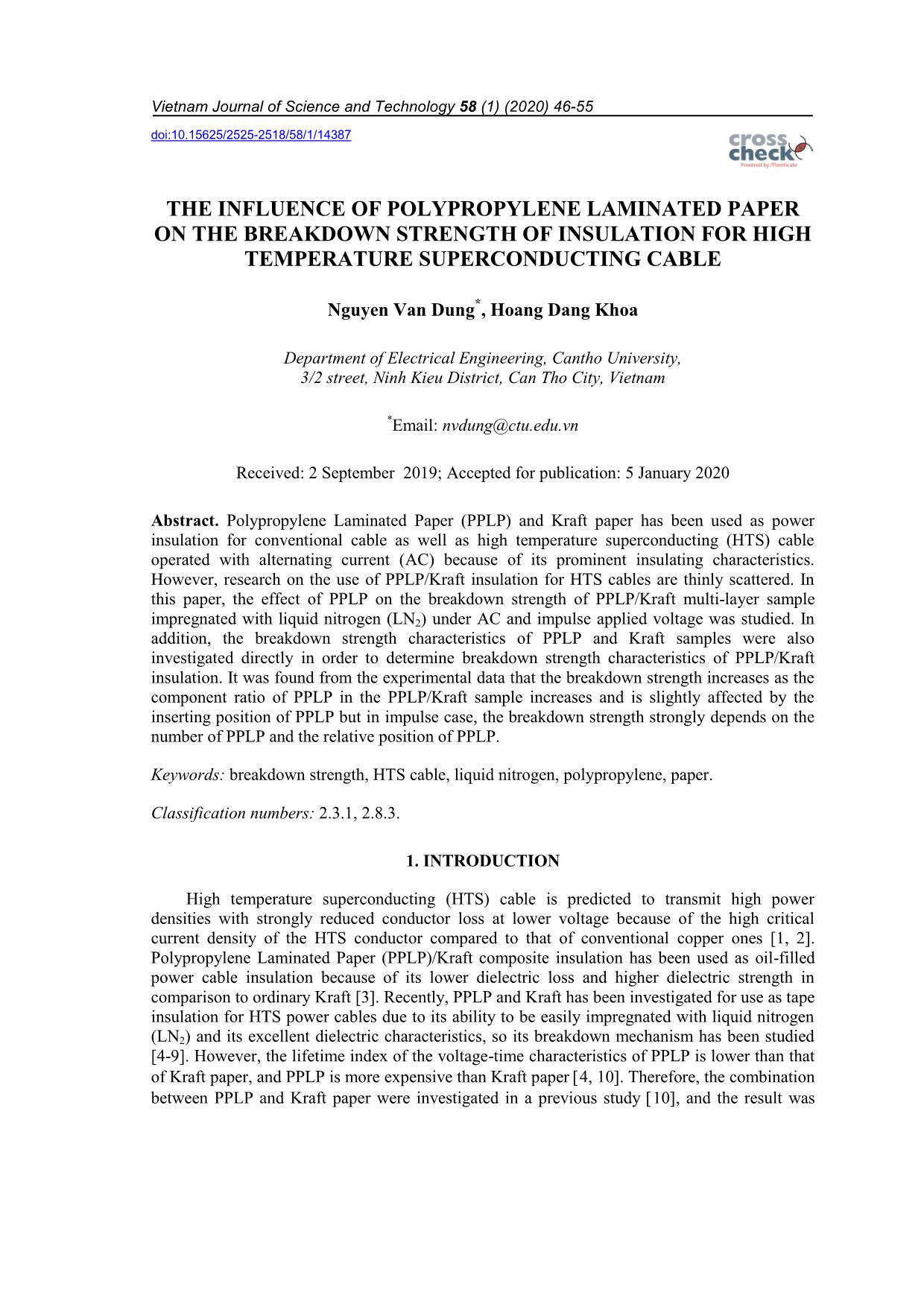
Trang 1
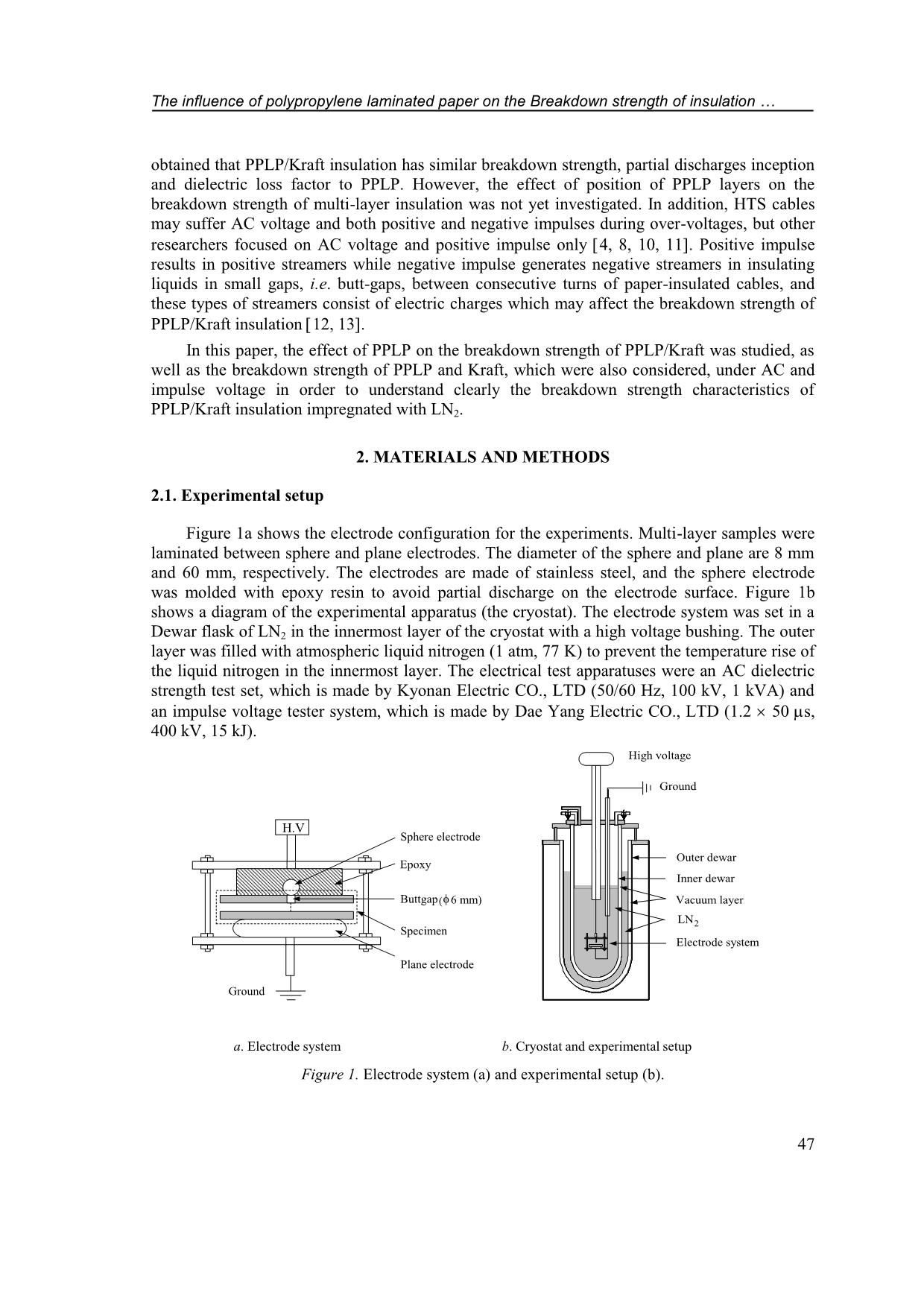
Trang 2
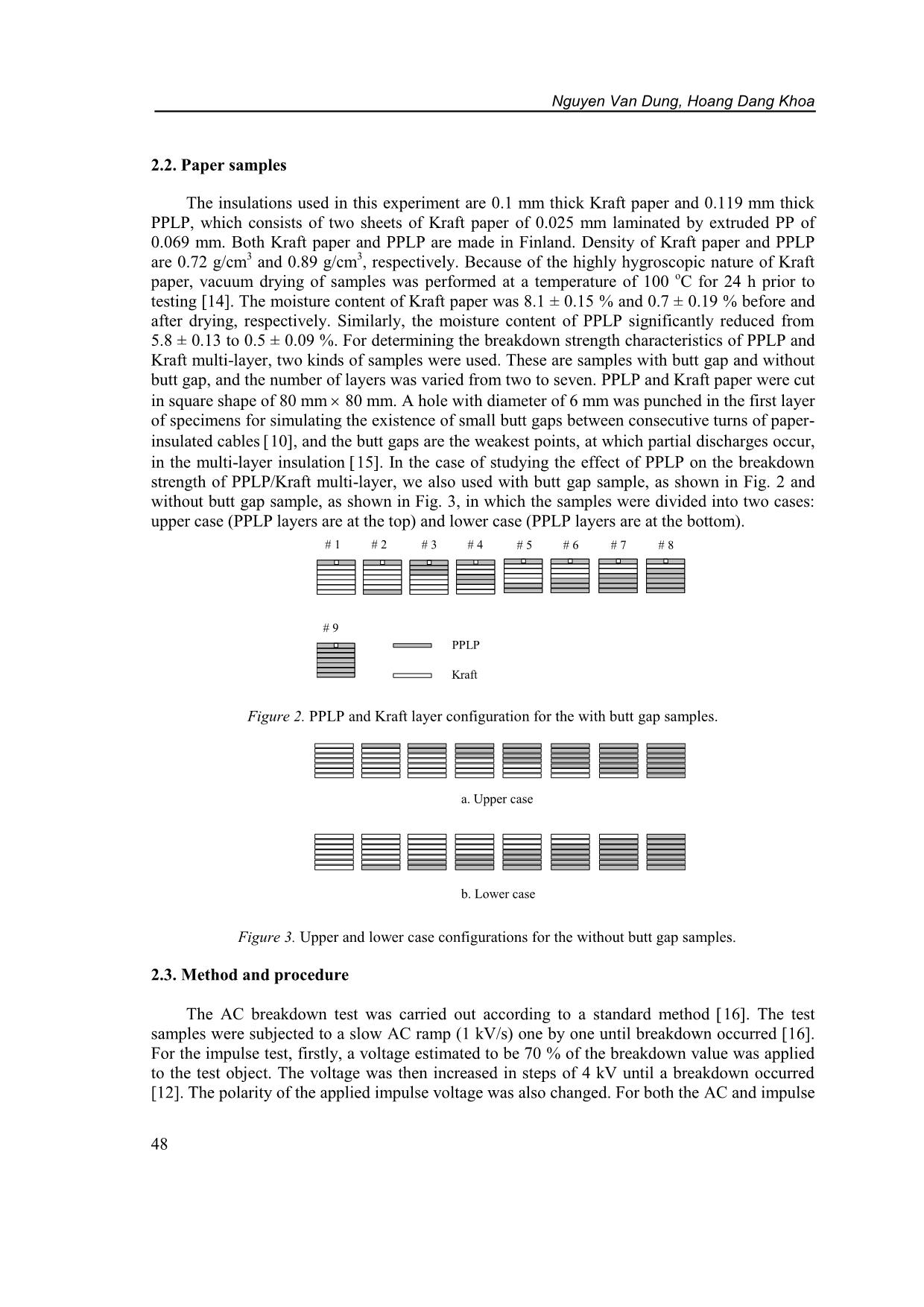
Trang 3
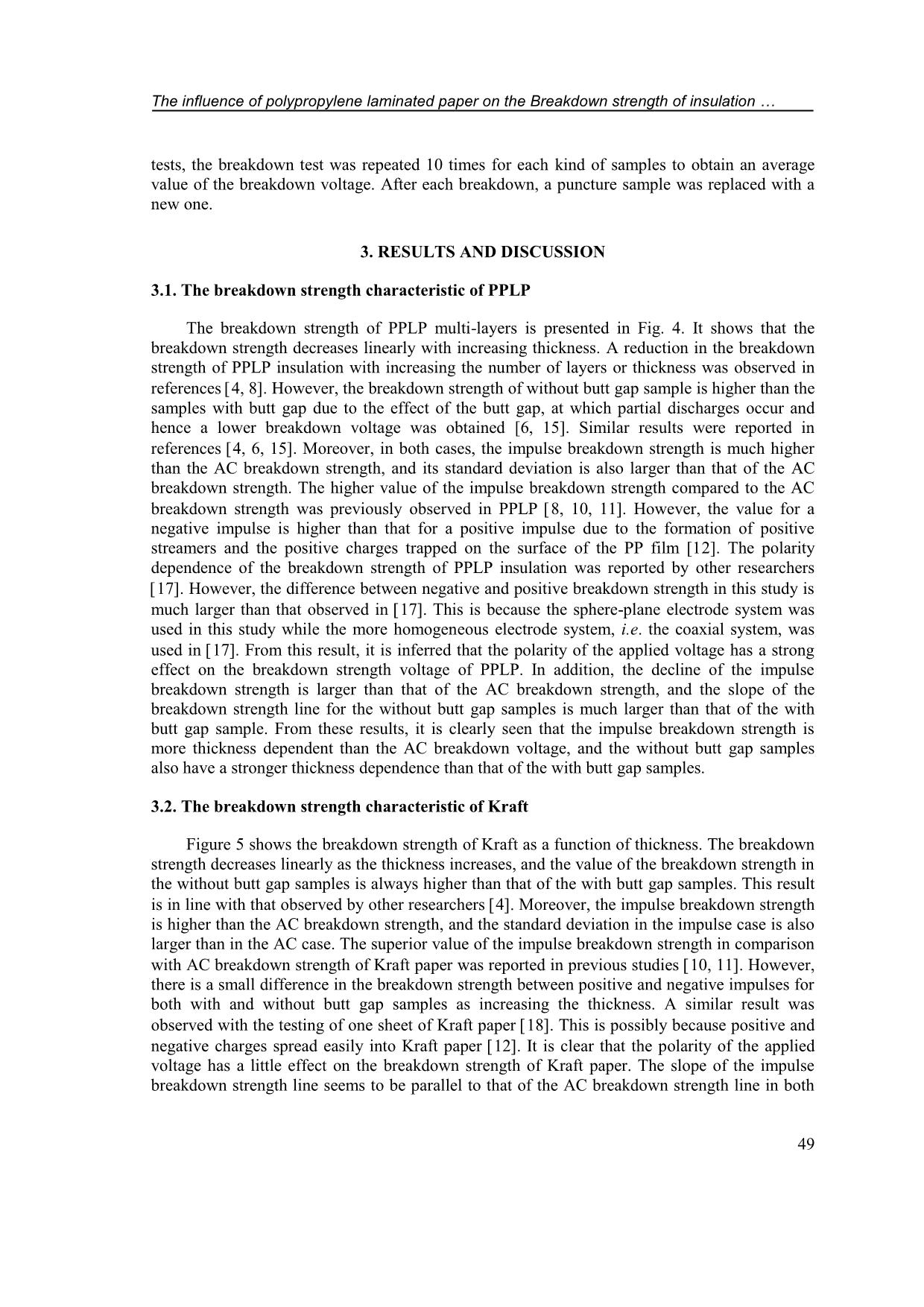
Trang 4
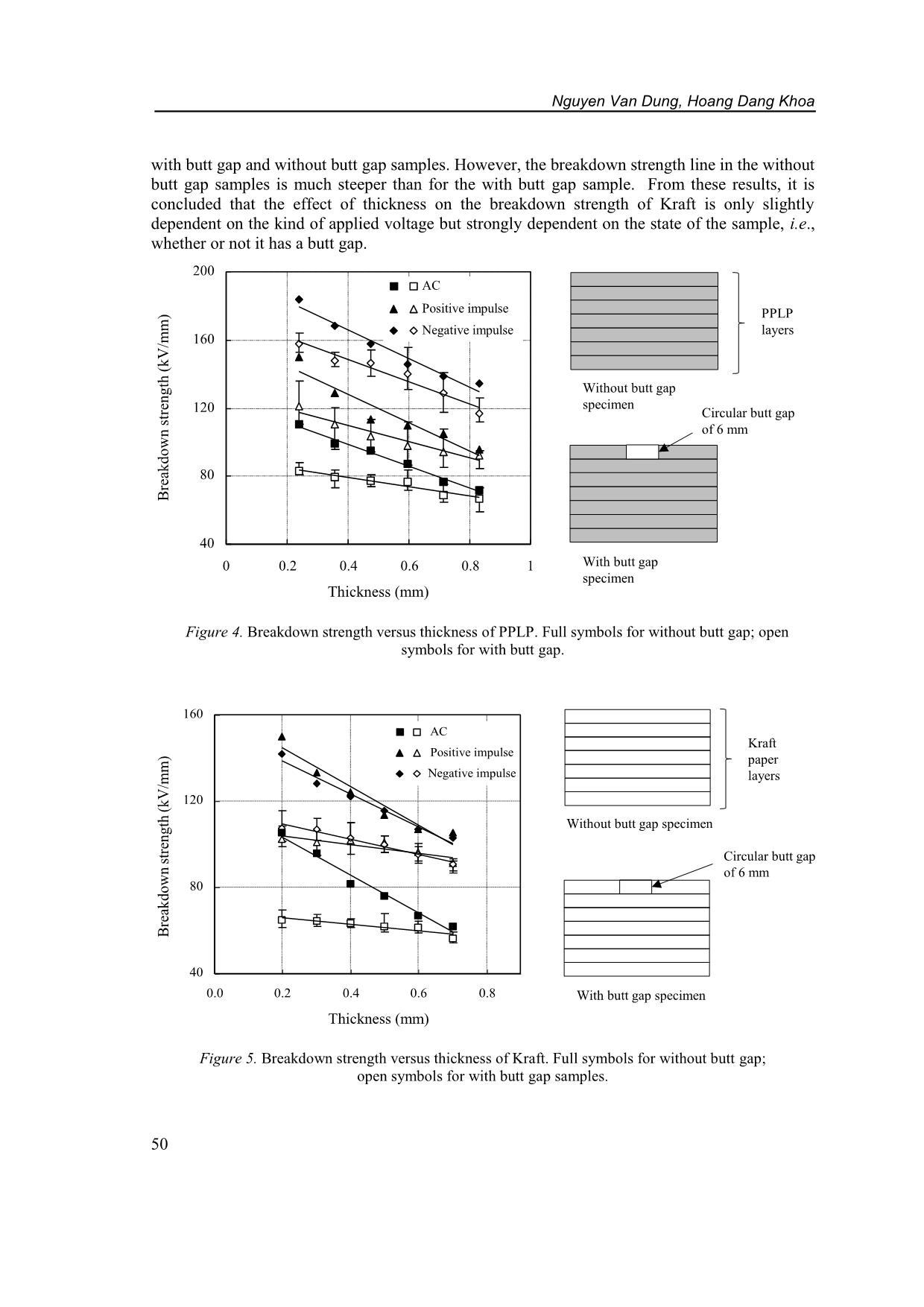
Trang 5
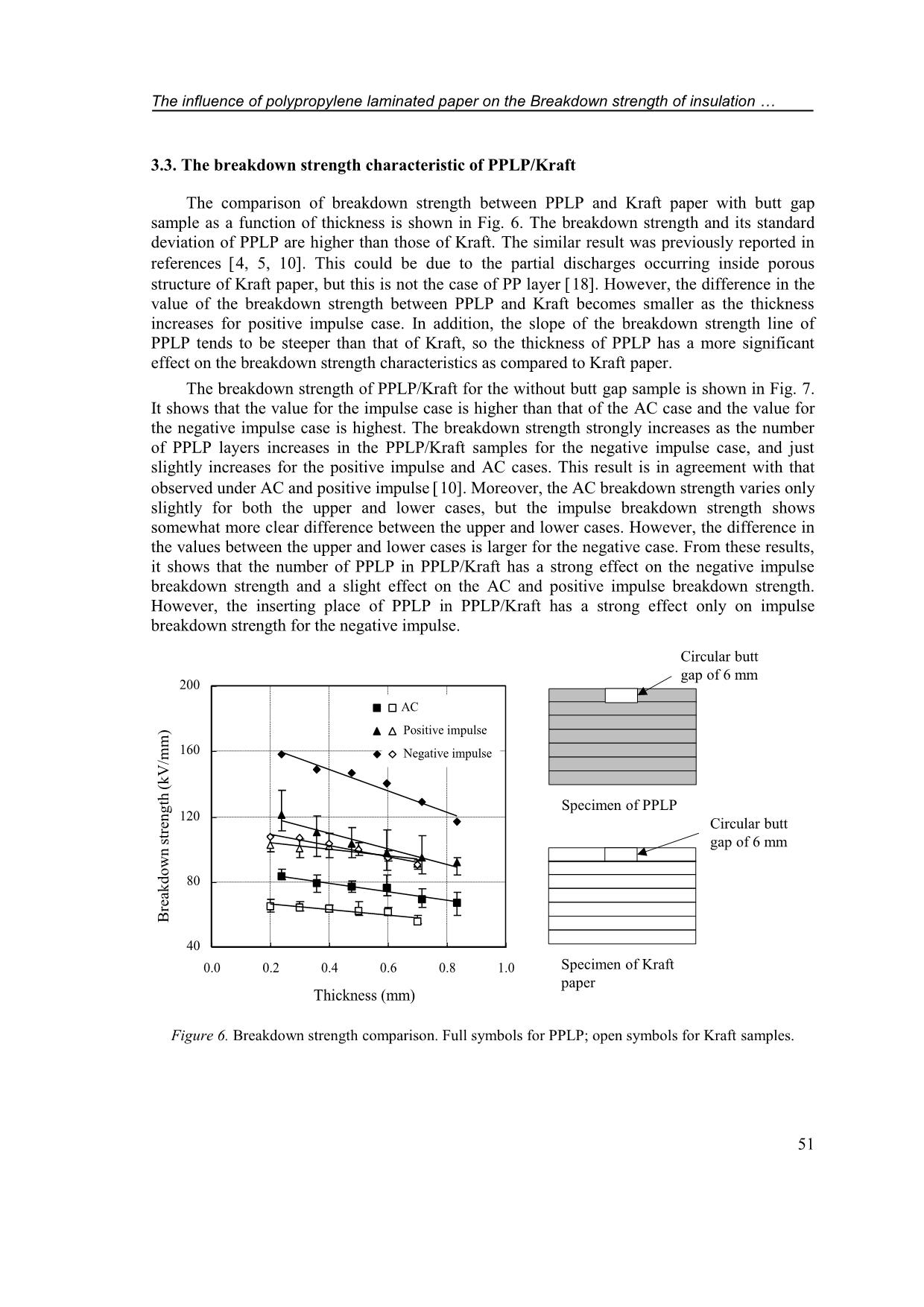
Trang 6
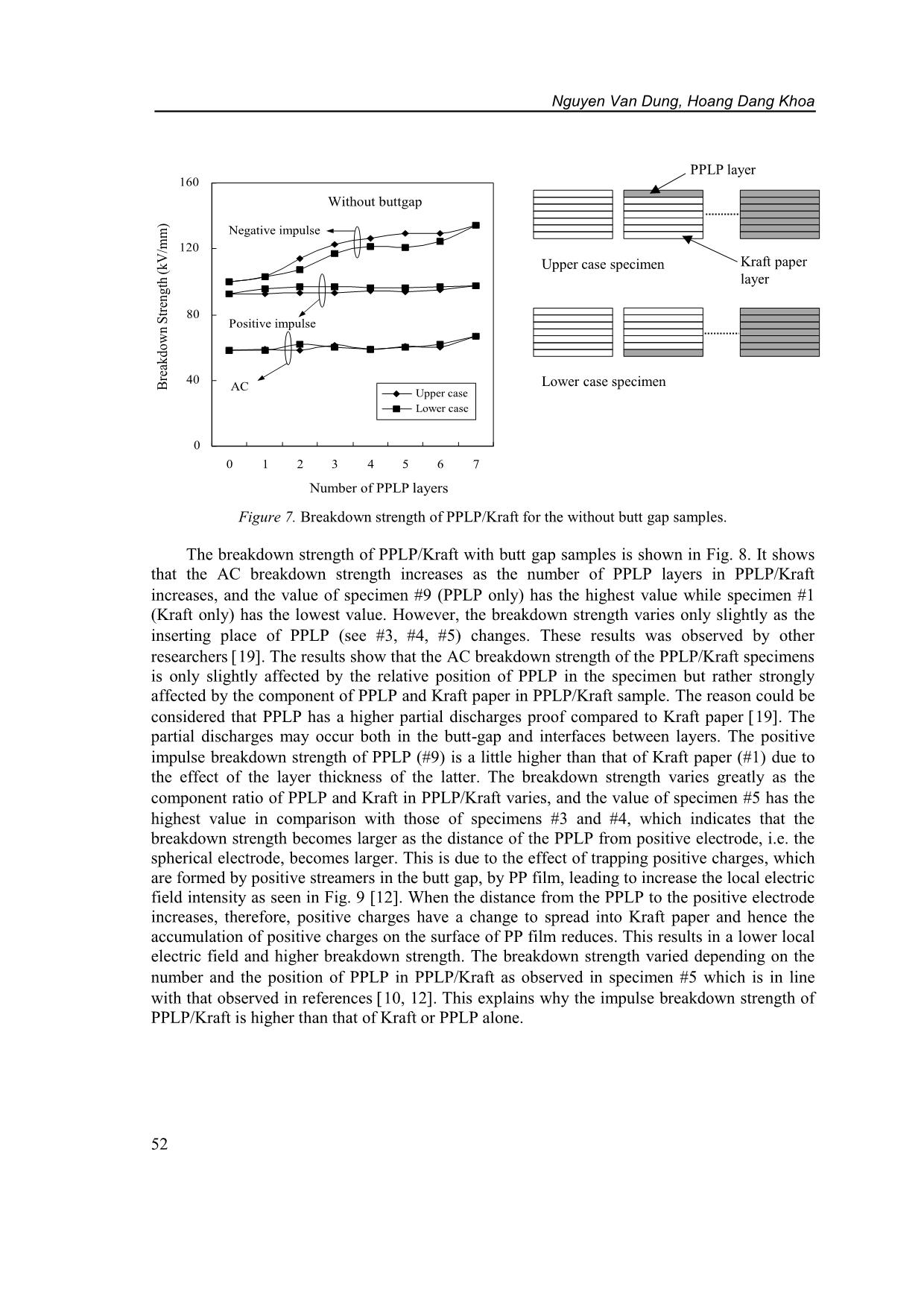
Trang 7
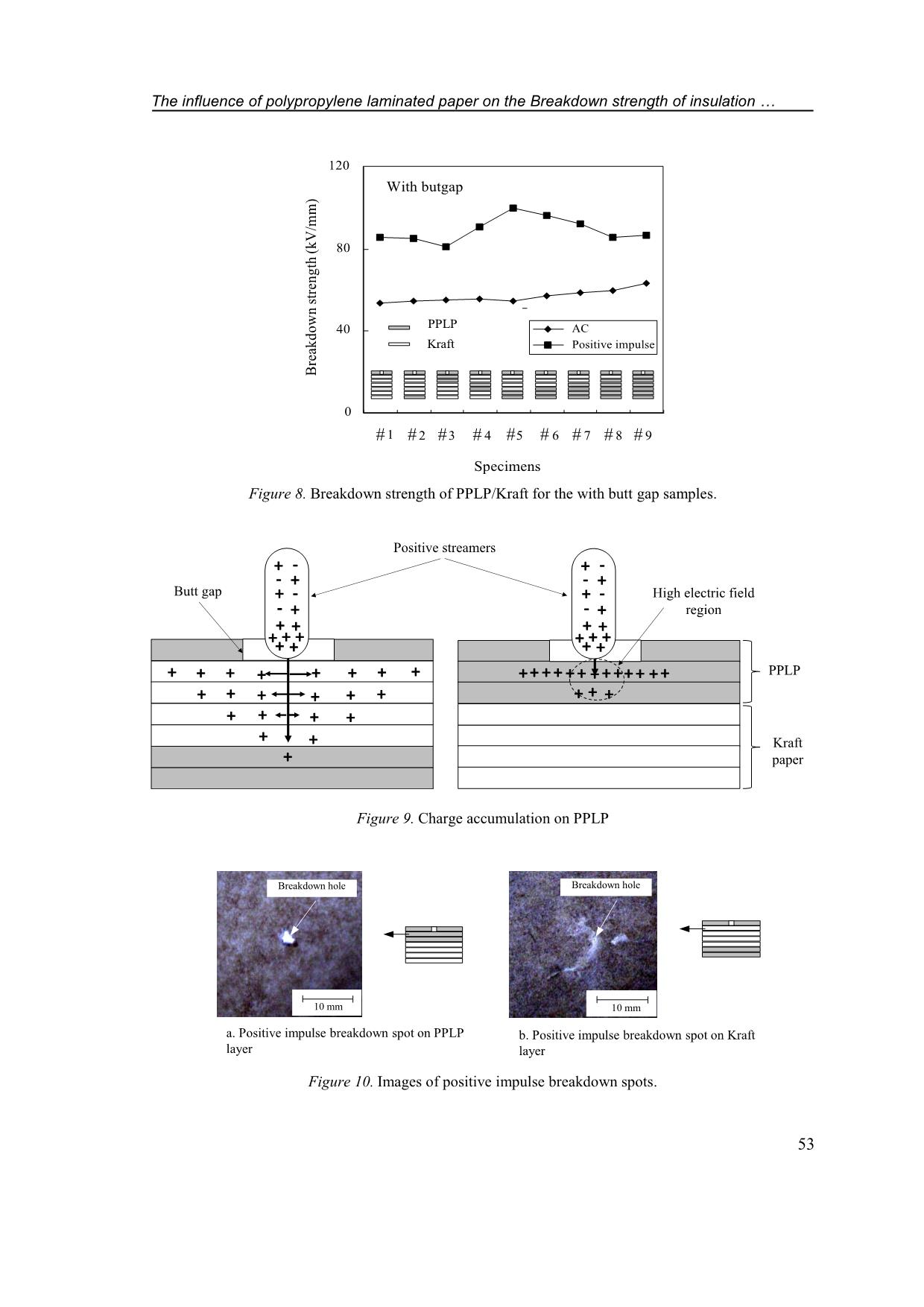
Trang 8
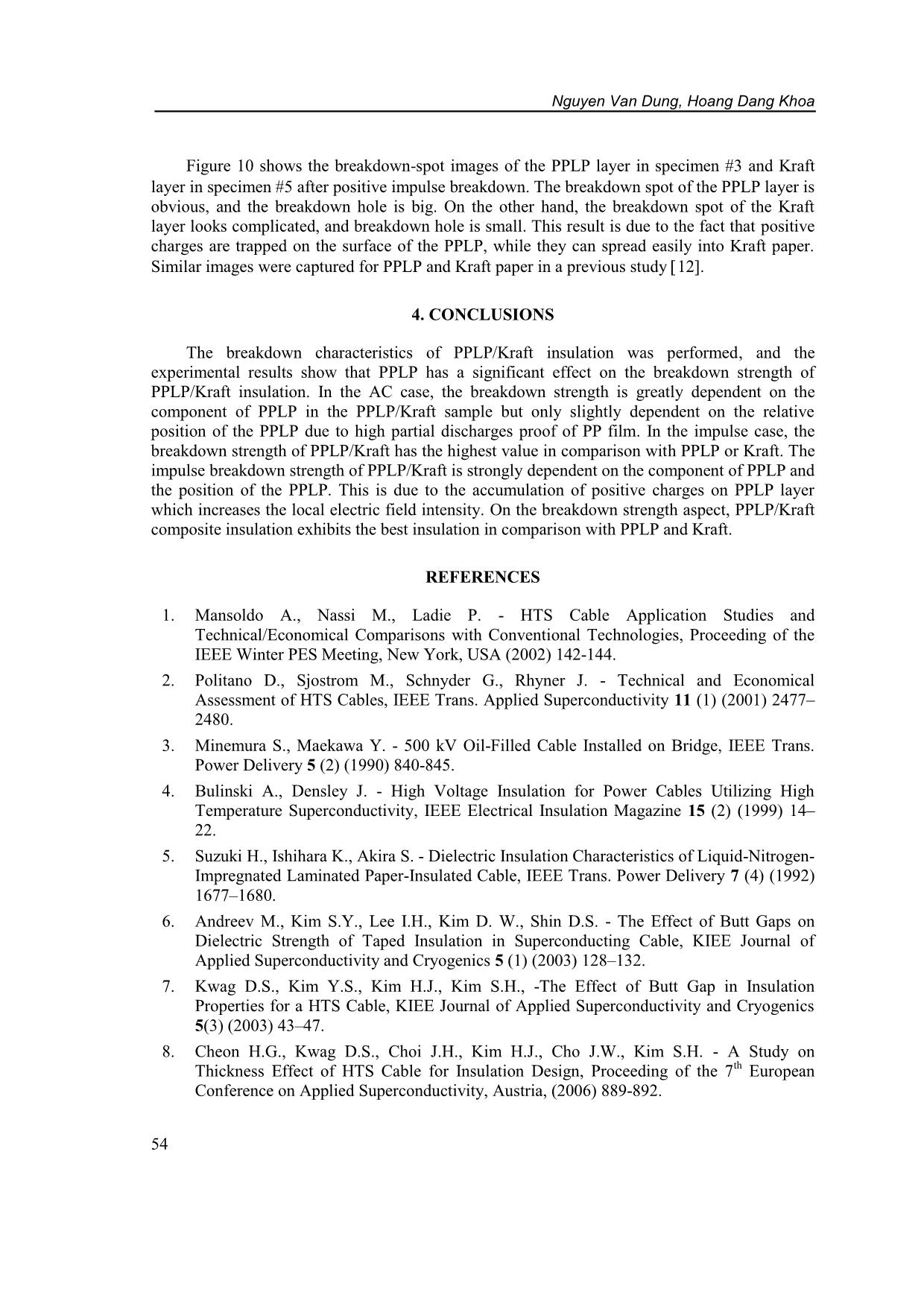
Trang 9
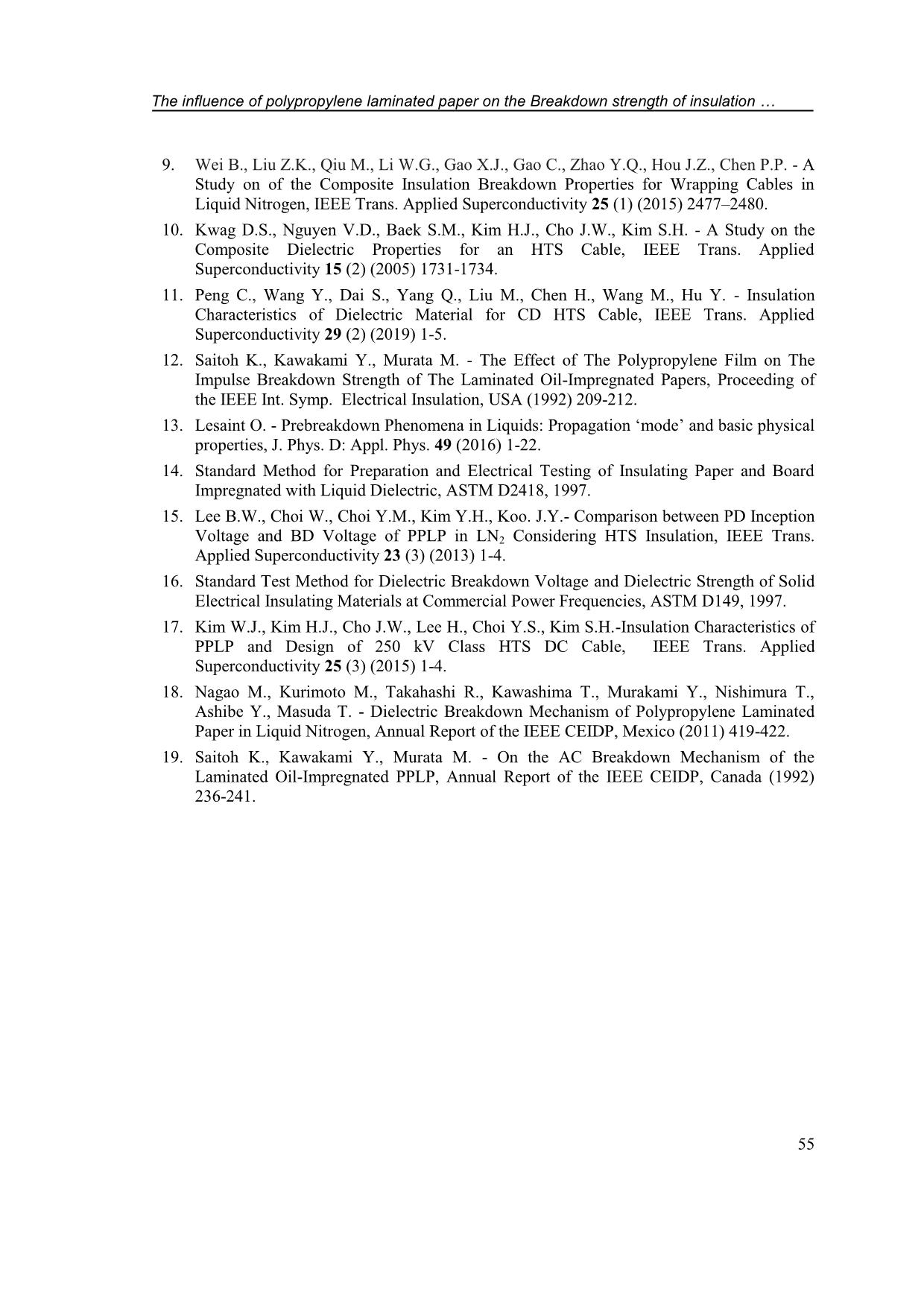
Trang 10
Tóm tắt nội dung tài liệu: The influence of polypropylene laminated paper on the breakdown strength of insulation for high temperature superconducting cable
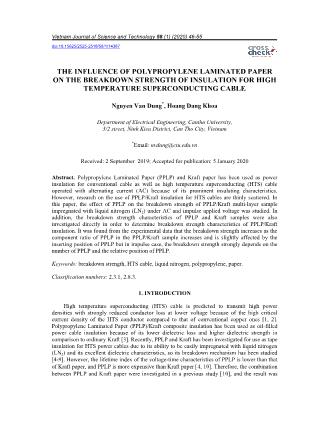
trength of PPLP insulation was reported by other researchers 17. However, the difference between negative and positive breakdown strength in this study is much larger than that observed in 17. This is because the sphere-plane electrode system was used in this study while the more homogeneous electrode system, i.e. the coaxial system, was used in 17. From this result, it is inferred that the polarity of the applied voltage has a strong effect on the breakdown strength voltage of PPLP. In addition, the decline of the impulse breakdown strength is larger than that of the AC breakdown strength, and the slope of the breakdown strength line for the without butt gap samples is much larger than that of the with butt gap sample. From these results, it is clearly seen that the impulse breakdown strength is more thickness dependent than the AC breakdown voltage, and the without butt gap samples also have a stronger thickness dependence than that of the with butt gap samples. 3.2. The breakdown strength characteristic of Kraft Figure 5 shows the breakdown strength of Kraft as a function of thickness. The breakdown strength decreases linearly as the thickness increases, and the value of the breakdown strength in the without butt gap samples is always higher than that of the with butt gap samples. This result is in line with that observed by other researchers 4. Moreover, the impulse breakdown strength is higher than the AC breakdown strength, and the standard deviation in the impulse case is also larger than in the AC case. The superior value of the impulse breakdown strength in comparison with AC breakdown strength of Kraft paper was reported in previous studies 10, 11. However, there is a small difference in the breakdown strength between positive and negative impulses for both with and without butt gap samples as increasing the thickness. A similar result was observed with the testing of one sheet of Kraft paper 18. This is possibly because positive and negative charges spread easily into Kraft paper 12. It is clear that the polarity of the applied voltage has a little effect on the breakdown strength of Kraft paper. The slope of the impulse breakdown strength line seems to be parallel to that of the AC breakdown strength line in both Nguyen Van Dung, Hoang Dang Khoa 50 with butt gap and without butt gap samples. However, the breakdown strength line in the without butt gap samples is much steeper than for the with butt gap sample. From these results, it is concluded that the effect of thickness on the breakdown strength of Kraft is only slightly dependent on the kind of applied voltage but strongly dependent on the state of the sample, i.e., whether or not it has a butt gap. Figure 4. Breakdown strength versus thickness of PPLP. Full symbols for without butt gap; open symbols for with butt gap. Figure 5. Breakdown strength versus thickness of Kraft. Full symbols for without butt gap; open symbols for with butt gap samples. 40 80 120 160 200 0 0.2 0.4 0.6 0.8 1 Thickness (mm) B re ak d o w n s tr en g th ( k V /m m ) AC Positive impulse Negative impulse Circular butt gap of 6 mm With butt gap specimen Without butt gap specimen PPLP layers 40 80 120 160 0.0 0.2 0.4 0.6 0.8 Thickness (mm) B re ak d o w n s tr en g th ( k V /m m ) AC Positive impulse Negative impulse Circular butt gap of 6 mm With butt gap specimen Without butt gap specimen Kraft paper layers The influence of polypropylene laminated paper on the Breakdown strength of insulation 51 3.3. The breakdown strength characteristic of PPLP/Kraft The comparison of breakdown strength between PPLP and Kraft paper with butt gap sample as a function of thickness is shown in Fig. 6. The breakdown strength and its standard deviation of PPLP are higher than those of Kraft. The similar result was previously reported in references 4, 5, 10. This could be due to the partial discharges occurring inside porous structure of Kraft paper, but this is not the case of PP layer 18. However, the difference in the value of the breakdown strength between PPLP and Kraft becomes smaller as the thickness increases for positive impulse case. In addition, the slope of the breakdown strength line of PPLP tends to be steeper than that of Kraft, so the thickness of PPLP has a more significant effect on the breakdown strength characteristics as compared to Kraft paper. The breakdown strength of PPLP/Kraft for the without butt gap sample is shown in Fig. 7. It shows that the value for the impulse case is higher than that of the AC case and the value for the negative impulse case is highest. The breakdown strength strongly increases as the number of PPLP layers increases in the PPLP/Kraft samples for the negative impulse case, and just slightly increases for the positive impulse and AC cases. This result is in agreement with that observed under AC and positive impulse 10. Moreover, the AC breakdown strength varies only slightly for both the upper and lower cases, but the impulse breakdown strength shows somewhat more clear difference between the upper and lower cases. However, the difference in the values between the upper and lower cases is larger for the negative case. From these results, it shows that the number of PPLP in PPLP/Kraft has a strong effect on the negative impulse breakdown strength and a slight effect on the AC and positive impulse breakdown strength. However, the inserting place of PPLP in PPLP/Kraft has a strong effect only on impulse breakdown strength for the negative impulse. Figure 6. Breakdown strength comparison. Full symbols for PPLP; open symbols for Kraft samples. 40 80 120 160 200 0.0 0.2 0.4 0.6 0.8 1.0 Thickness (mm) B re a k d o w n s tr e n g th ( k V /m m ) AC Positive impulse Negative impulse Circular butt gap of 6 mm Specimen of PPLP Circular butt gap of 6 mm Specimen of Kraft paper Nguyen Van Dung, Hoang Dang Khoa 52 Figure 7. Breakdown strength of PPLP/Kraft for the without butt gap samples. The breakdown strength of PPLP/Kraft with butt gap samples is shown in Fig. 8. It shows that the AC breakdown strength increases as the number of PPLP layers in PPLP/Kraft increases, and the value of specimen 9 (PPLP only) has the highest value while specimen 1 (Kraft only) has the lowest value. However, the breakdown strength varies only slightly as the inserting place of PPLP (see 3, 4, 5) changes. These results was observed by other researchers 19. The results show that the AC breakdown strength of the PPLP/Kraft specimens is only slightly affected by the relative position of PPLP in the specimen but rather strongly affected by the component of PPLP and Kraft paper in PPLP/Kraft sample. The reason could be considered that PPLP has a higher partial discharges proof compared to Kraft paper 19. The partial discharges may occur both in the butt-gap and interfaces between layers. The positive impulse breakdown strength of PPLP (9) is a little higher than that of Kraft paper (1) due to the effect of the layer thickness of the latter. The breakdown strength varies greatly as the component ratio of PPLP and Kraft in PPLP/Kraft varies, and the value of specimen 5 has the highest value in comparison with those of specimens 3 and 4, which indicates that the breakdown strength becomes larger as the distance of the PPLP from positive electrode, i.e. the spherical electrode, becomes larger. This is due to the effect of trapping positive charges, which are formed by positive streamers in the butt gap, by PP film, leading to increase the local electric field intensity as seen in Fig. 9 [12]. When the distance from the PPLP to the positive electrode increases, therefore, positive charges have a change to spread into Kraft paper and hence the accumulation of positive charges on the surface of PP film reduces. This results in a lower local electric field and higher breakdown strength. The breakdown strength varied depending on the number and the position of PPLP in PPLP/Kraft as observed in specimen 5 which is in line with that observed in references 10, 12. This explains why the impulse breakdown strength of PPLP/Kraft is higher than that of Kraft or PPLP alone. Without buttgap 0 40 80 120 160 0 1 2 3 4 5 6 7 Number of PPLP B re ak d o w n S tr en g th ( k V /m m ) Negative impulse Positive impulse AC Upper case Lower case layers Lower case specimen Upper case specimen PPLP layer Kraft paper layer The influence of polypropylene laminated paper on the Breakdown strength of insulation 53 Figure 8. Breakdown strength of PPLP/Kraft for the with butt gap samples. Figure 9. Charge accumulation on PPLP Figure 10. Images of positive impulse breakdown spots. 0 40 80 120 B re ak d o w n s tr en g th ( k V /m m ) Specimens 1 98765432 AC Positive impulse With butgap PPLP Kraft + + ++++ + + + - - - - + + + + + + + + + + + + + + + + + + + + ++ + + + ++++ + + + - - - - + + + +++ +++++ ++ + + + + + Positive streamers High electric field region PPLP Kraft paper Butt gap Breakdown hole 10 mm Breakdown hole 10 mm a. Positive impulse breakdown spot on PPLP layer b. Positive impulse breakdown spot on Kraft layer Nguyen Van Dung, Hoang Dang Khoa 54 Figure 10 shows the breakdown-spot images of the PPLP layer in specimen 3 and Kraft layer in specimen 5 after positive impulse breakdown. The breakdown spot of the PPLP layer is obvious, and the breakdown hole is big. On the other hand, the breakdown spot of the Kraft layer looks complicated, and breakdown hole is small. This result is due to the fact that positive charges are trapped on the surface of the PPLP, while they can spread easily into Kraft paper. Similar images were captured for PPLP and Kraft paper in a previous study 12. 4. CONCLUSIONS The breakdown characteristics of PPLP/Kraft insulation was performed, and the experimental results show that PPLP has a significant effect on the breakdown strength of PPLP/Kraft insulation. In the AC case, the breakdown strength is greatly dependent on the component of PPLP in the PPLP/Kraft sample but only slightly dependent on the relative position of the PPLP due to high partial discharges proof of PP film. In the impulse case, the breakdown strength of PPLP/Kraft has the highest value in comparison with PPLP or Kraft. The impulse breakdown strength of PPLP/Kraft is strongly dependent on the component of PPLP and the position of the PPLP. This is due to the accumulation of positive charges on PPLP layer which increases the local electric field intensity. On the breakdown strength aspect, PPLP/Kraft composite insulation exhibits the best insulation in comparison with PPLP and Kraft. REFERENCES 1. Mansoldo A., Nassi M., Ladie P. - HTS Cable Application Studies and Technical/Economical Comparisons with Conventional Technologies, Proceeding of the IEEE Winter PES Meeting, New York, USA (2002) 142-144. 2. Politano D., Sjostrom M., Schnyder G., Rhyner J. - Technical and Economical Assessment of HTS Cables, IEEE Trans. Applied Superconductivity 11 (1) (2001) 2477– 2480. 3. Minemura S., Maekawa Y. - 500 kV Oil-Filled Cable Installed on Bridge, IEEE Trans. Power Delivery 5 (2) (1990) 840-845. 4. Bulinski A., Densley J. - High Voltage Insulation for Power Cables Utilizing High Temperature Superconductivity, IEEE Electrical Insulation Magazine 15 (2) (1999) 14– 22. 5. Suzuki H., Ishihara K., Akira S. - Dielectric Insulation Characteristics of Liquid-Nitrogen- Impregnated Laminated Paper-Insulated Cable, IEEE Trans. Power Delivery 7 (4) (1992) 1677–1680. 6. Andreev M., Kim S.Y., Lee I.H., Kim D. W., Shin D.S. - The Effect of Butt Gaps on Dielectric Strength of Taped Insulation in Superconducting Cable, KIEE Journal of Applied Superconductivity and Cryogenics 5 (1) (2003) 128–132. 7. Kwag D.S., Kim Y.S., Kim H.J., Kim S.H., -The Effect of Butt Gap in Insulation Properties for a HTS Cable, KIEE Journal of Applied Superconductivity and Cryogenics 5(3) (2003) 43–47. 8. Cheon H.G., Kwag D.S., Choi J.H., Kim H.J., Cho J.W., Kim S.H. - A Study on Thickness Effect of HTS Cable for Insulation Design, Proceeding of the 7 th European Conference on Applied Superconductivity, Austria, (2006) 889-892. The influence of polypropylene laminated paper on the Breakdown strength of insulation 55 9. Wei B., Liu Z.K., Qiu M., Li W.G., Gao X.J., Gao C., Zhao Y.Q., Hou J.Z., Chen P.P. - A Study on of the Composite Insulation Breakdown Properties for Wrapping Cables in Liquid Nitrogen, IEEE Trans. Applied Superconductivity 25 (1) (2015) 2477–2480. 10. Kwag D.S., Nguyen V.D., Baek S.M., Kim H.J., Cho J.W., Kim S.H. - A Study on the Composite Dielectric Properties for an HTS Cable, IEEE Trans. Applied Superconductivity 15 (2) (2005) 1731-1734. 11. Peng C., Wang Y., Dai S., Yang Q., Liu M., Chen H., Wang M., Hu Y. - Insulation Characteristics of Dielectric Material for CD HTS Cable, IEEE Trans. Applied Superconductivity 29 (2) (2019) 1-5. 12. Saitoh K., Kawakami Y., Murata M. - The Effect of The Polypropylene Film on The Impulse Breakdown Strength of The Laminated Oil-Impregnated Papers, Proceeding of the IEEE Int. Symp. Electrical Insulation, USA (1992) 209-212. 13. Lesaint O. - Prebreakdown Phenomena in Liquids: Propagation ‘mode’ and basic physical properties, J. Phys. D: Appl. Phys. 49 (2016) 1-22. 14. Standard Method for Preparation and Electrical Testing of Insulating Paper and Board Impregnated with Liquid Dielectric, ASTM D2418, 1997. 15. Lee B.W., Choi W., Choi Y.M., Kim Y.H., Koo. J.Y.- Comparison between PD Inception Voltage and BD Voltage of PPLP in LN2 Considering HTS Insulation, IEEE Trans. Applied Superconductivity 23 (3) (2013) 1-4. 16. Standard Test Method for Dielectric Breakdown Voltage and Dielectric Strength of Solid Electrical Insulating Materials at Commercial Power Frequencies, ASTM D149, 1997. 17. Kim W.J., Kim H.J., Cho J.W., Lee H., Choi Y.S., Kim S.H.-Insulation Characteristics of PPLP and Design of 250 kV Class HTS DC Cable, IEEE Trans. Applied Superconductivity 25 (3) (2015) 1-4. 18. Nagao M., Kurimoto M., Takahashi R., Kawashima T., Murakami Y., Nishimura T., Ashibe Y., Masuda T. - Dielectric Breakdown Mechanism of Polypropylene Laminated Paper in Liquid Nitrogen, Annual Report of the IEEE CEIDP, Mexico (2011) 419-422. 19. Saitoh K., Kawakami Y., Murata M. - On the AC Breakdown Mechanism of the Laminated Oil-Impregnated PPLP, Annual Report of the IEEE CEIDP, Canada (1992) 236-241.
File đính kèm:
 the_influence_of_polypropylene_laminated_paper_on_the_breakd.pdf
the_influence_of_polypropylene_laminated_paper_on_the_breakd.pdf

